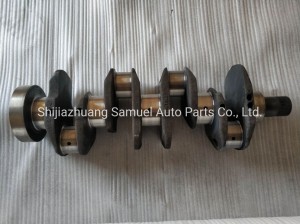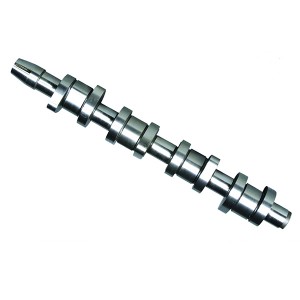Applicable car models: Volkswagen
model: 038109101R /038109101AH
Impact strength: 1000(mPa)
Package dimensions: 500*20*20
Article number: YD358A
product description:
Camshafts are a critical part of the engine and are connected to the crankshaft via chains or belts (timing belt, timing chains), camshafts are driven by the camshafts and also control the valves. This relationship controls the air to fuel mixtures (traditional injection systems) and exhaust outlet via operation of the values.
The product is made of high-strength ductile iron and treated by surface strengthening technology to improve the fatigue strength of the camshaft. It is suitable for automobiles, ships, engineering vehicles, agricultural machinery, generator set,original quality, with good appearance, high density, smoothness, brightness and durability after finishing. Each product has undergone rigorous testing and its quality has been guaranteed. Box packaging has a good appearance and durable production cycle: 20-30 working days, neutral packaging/original packaging, mode of transportation: land, sea and air.
The Camshaft operates these valves by lobes located on the camshaft shaft themselves, as they rotate around pressing the valves downwards. The valves are spring loaded ( can be pressured air actuated) and return to the original location, waiting for the next time the lobes rotate back round, continuing the cycle. There are both air inlet and exhaust outlet valves and on some engine design like DOHC (double overhead cam) can have two sets of valves per inlet or outlet.
You can imagine that the crankshaft is connected to the camshafts via the cambelt, and the camshafts are connected to the valves, all working in synergy. During normal operating conditions a standard camshaft profile could be tailored for certain engine characteristics, but there are variable value set-ups which can even changed the cam profile for performance use- Honda is especially known for such technologies.
Common failures of camshafts include abnormal wear, abnormal noise, and fracture. Abnormal wear and tear often occur before abnormal noise and fracture occur.
(1) The camshaft is located almost at the end of the engine lubrication system, so the lubrication situation is not optimistic. If the oil pump has insufficient supply pressure due to excessive use time or other reasons, or the lubricating oil passage is blocked, the lubricating oil cannot reach the camshaft, or the tightening torque of the bearing cap tightening bolt is too large, the lubricating oil cannot enter the camshaft gap. Causes abnormal wear of the camshaft.
(2) Abnormal wear of the camshaft will cause the gap between the camshaft and the bearing housing to increase, and axial displacement will occur when the camshaft moves, resulting in abnormal noise. Abnormal wear will also lead to an increase in the gap between the drive cam and the hydraulic tappet. When the cam and the hydraulic tappet are combined, an impact will occur, resulting in an abnormal noise.
(3) Camshafts sometimes have severe failures such as breakage. Common causes include hydraulic tappets cracking or severe wear, severe poor lubrication, poor quality camshafts, and camshaft timing gear ruptures.
(4) In some cases, the failure of the camshaft is caused by human reasons, especially when the engine is not properly disassembled when the engine is repaired. For example, when disassembling the camshaft bearing cover, use a hammer to strike strongly or use a screwdriver to pry the pressure, or install the bearing cover in the wrong position, so the bearing cover does not match the bearing seat, or the tightening torque of the bearing cover fastening bolt is too large. When installing the bearing cover, pay attention to the direction arrows and position numbers on the surface of the bearing cover, and use a torque wrench to tighten the bearing cover tightening bolts strictly in accordance with the specified torque.



